For more stories like this one, subscribe to A People's History of Kansas City on Apple Podcasts or Spotify.
The name of Colonel Thomas Hunton Swope is engraved in Kansas City's landscape: You may have walked through Swope Park, driven on Swope Parkway or received care at Swope Health Center.
But Swope, a well-known philanthropist whose generosity reshaped Kansas City in the late 1800s, became famous for something else entirely: dying under suspicious circumstances.
After Swope passed away in October 1909, his death became the subject of one of the most publicized murder trials of the early 20th century.
For more than a century, lawyers, detectives, pathologists, reporters and historians have pried into the evidence — most notably the late Kansas City author Giles Fowler in his 2009 book, "Deaths on Pleasant Street."
At the center of the case was a question that captivated the nation: Was this reclusive millionaire poisoned by his own nephew-in-law — the prominent Kansas City physician Dr. Bennett Clark Hyde, who stood to inherit a sizable portion of the Swope family fortune?
Or were the deaths merely unfortunate accidents, pinned on Hyde as part of a years-long family grudge?
“If murder there was, it rivals the most grewsome (sic) tales of French fiction in its diabolical conception and boldness of execution. Every feature of the veiled hypothesis is a ghastly enigma of human depravity,” read the Kansas City Journal in January 1910.

Who was Thomas Swope?
Born in Kentucky in 1827, Thomas Swope made his way to Kansas City around 1857 in search of fortune, which he found in the Kansas City real estate market.

Accurately anticipating that Kansas City would grow south of the Missouri River, Swope purchased up much of the land that makes up downtown Kansas City today.
“He basically becomes rich subdividing that farmland and reselling it to other investors,” says Michael Wells, a special collections librarian at the Kansas City Public Library.
As a token of appreciation, Swope invested much of his fortune directly back into the city it came from. Although he was a notoriously private individual, Swope gave generously to area hospitals and the YMCA, and had a soft spot for animals and organizations like the Humane Society.
Most notably, though, he donated 1,334 acres of land to Kansas City in 1896 for what would become Swope Park — the largest park in the city and one of the largest municipal parks in the country.

Looking back, historians believe Swope had an ulterior motive for the gift. The real estate mogul was an active opponent of Kansas City's "City Beautiful" plan that would increase property taxes in order to pay for public goods like parks and boulevards.
But that didn’t particularly matter to the estimated 18,000 Kansas Citians who came to celebrate Swope Park's opening in June 1896.
“I have often heard it said that gratitude is a scarce article in this world, but from this time on I shall reject and ignore that pessimistic sentiment," Swope wrote in a statement to a reporter.

Today, now expanded to 1,805 acres, Swope Park boasts hiking trails, mountain bike paths, the Swope Memorial Golf Course, the Starlight Theatre and the Kansas City Zoo.
Who was Dr. Bennett Hyde?
Born in 1872 to a prominent family in Lexington, Missouri, Bennett Clark Hyde was a graduate of both William Jewell College and the University Medical College.

In addition to his up-and-coming career as a physician in Kansas City, Hyde was known for having a beautiful singing voice and being able to recite Shakespeare’s soliloquies by heart.
Hyde’s introduction to the Swope family occurred in 1903, when he started going steady with Thomas Swope’s eldest niece, Frances.
23-year-old Frances was immediately smitten with the 31-year-old Hyde, but the doctor's somewhat scandalous reputation in town gave her family pause.
“Because there are skeletons in them dark closets of Dr. Hyde,” says Ralph Monaco, a Kansas City lawyer and author of "The Strange Story of Col. Swope & Dr. Hyde." “Dr. Hyde had been known to escort older women and fleece them from their dollars.”
In 1897, when Hyde — who was white — was the Kansas City Police surgeon, he was accused of abusing a Black woman named Annie Clemmons. After protests from community leaders and church officials, Hyde was removed from his position.
The following year, Hyde was arrested for being the ringleader of a major grave robbing ring. He was accused of hiring a "gang of ghouls" to "systemically rob" local cemeteries in order to source cadavers for the medical college.

“He seems to think that if he can just smile and shake enough hands, that these things will just go away. And, you know, it does seem to work for him,” Wells says.
It’s impossible to know how much of Hyde’s checkered past was known to Frances’ mother at the time, but when Hyde proposed, Maggie Swope made it clear that she did not give her blessing.
But what was an infatuated woman to do?
On June 21, 1905, Frances and Dr. Hyde eloped. The headline of The Kansas City Star the following day read: "A Wedding in Fayetteville, Ark., Proves a Surprise to the Bride's Mother."
After the wedding, Frances Hyde and Maggie Swope ceased all forms of communication.

Their feud more or less continued until October 1907. After Frances’ brother was badly wounded in a Nevada mine, it was Hyde whom Maggie called for medical help.
“Maggie eventually accepts Hyde into the family, notwithstanding these skeletons in his closet,” Monaco says.
Thomas Swope bought the couple a house at 3516 Forest Avenue — and Hyde's association with the Swope family gives his career a major boost.
“Hyde became president-elect of the Jackson County Medical Society. Well, why not? His [uncle-in-law] had donated all the land to the city to build the hospitals,” Monaco says.
(In case you're wondering — no, the name of Kansas City's Hyde Park, which was designed around 1886, is not connected in any way to Bennett Hyde.)
The scene of the alleged crimes

Like many good murder mysteries, this one takes place at a large family estate. The elaborate 26-room Swope mansion sat on Pleasant Street atop the highest hill in Independence, and stretched for 19 acres.
The original owner of the manor was Logan Swope, Thomas’ brother. But when Logan died, his wife took Thomas in. In 1909, the pair was sharing the estate with seven other family members, mostly Maggie's children.
“And [Thomas] was the old codger that lived upstairs!” Monaco says. “He was also an alcoholic who excessively smoked cigars.”

On Oct. 1, 1909, Thomas Swope’s beloved cousin, J. Moss Hunton, suffered a sudden stroke. Maggie Swope immediately sent word for Hyde and the family physician, Dr. George Twyman.
Together, the doctors decided that the best course of action was to “bleed” Hunton — so Hyde made an incision and went about draining Hunton’s blood into a basin.
“Where things start to go awry and where people start to notice is the amount of blood that he's taking out,” Wells says.
“Even Frances told her husband, ‘Deary, don't you think you've bled Moss enough?’” Monaco says.
Finally, after draining multiple pints of blood, Hyde stops. But within minutes of being bandaged up, 63-year-old Moss Hunton was dead.
At the time, no one really thought much of Hyde’s actions because bloodletting was relatively common practice, even into the early 1900s. But later on, the amount of blood in the basin — and whether the death was avoidable — would become a topic of heavy debate.

Two days later, it’s a somber Sunday morning at the Swope estate.
Thomas Swope wakes up. His personal nurse, Pearl Virginia Keller, goes upstairs to give him his breakfast, and, according to her, a digestive pill from Hyde.
Everything seems normal — until about 20 minutes later, when Thomas Swope breaks out into a cold sweat, starts violently quivering, and goes into a coma.
“Nurse Keller, in her trial testimony, stated that Colonel Swope regained consciousness and made a comment to the effect, ‘I wished I had never taken that damned pill, it's gonna kill me,’” Monaco says.
If true, Swope had frightening foresight. The 81-year-old died that same night.
The following week, in the middle of an ominous thunderstorm, the Swope family watched as Thomas Swope was brought to his temporary resting place at Forest Hill Cemetery. It would be nine years before his final gravesite — a memorial within Swope Park — was ready for him.
To say the least, the two seemingly-unrelated deaths were a shock to the Swope family. Sure, Thomas Swope’s health hadn’t been the best, but what are the odds he would die just two days after his cousin?
A cousin, by the way, who just so happened to be an executor of Swope’s will.
A fortune worth killing for?

At the time of Thomas Swope’s death, his fortune was estimated at about $3.6 million, which is the equivalent of more than $100 million today.
Curiously, though, in the days leading up to his death, Swope had been telling everyone that he wanted to change his will, which he wrote just a few years earlier.
“Swope was always planning to give a substantial portion of his estate to charity," Wells says. "However, as time went on, he started to think that maybe he needed to be giving even more and more to charity — and less to the family."
Following Swope's death, the family lawyer read the will, and it became immediately clear that the fortune was still firmly in Swope family hands.
Had Swope died just a few days later, however, it's possible he may have successfully rewritten the will — depriving each niece and nephew of $140,000 each, approximately $4 million today.
This is where Hyde appeared to have a personal investment in Swope's death — after all, his wife, Frances, was among those cousins set to benefit greatly under the original will. And Hyde himself had financially benefited from the powerful influence of Swope's money on the institutions of Kansas City.
According to Nurse Keller, mere hours after Hunton died, Hyde had offered up himself to be the new executor of Swope's will.
It also emerged that, two weeks before Thomas Swope accepted that capsule from Hyde, the physician had made two calls to Hugo Brecklein's drugstore downtown.
According to the book "Deaths on Pleasant Street," one of the calls was to order Fairchild's Holadin, a popular digestive compound made of animal glands that were powdered and put into capsules.
The other call was to order several capsules of cyanide — one of the quickest, most lethal poisons.
Reportedly, the two pills were identical in size, shape and color.
Typhoid fever invades

1909 was truly a dreadful year for the Swope family.
About a month after the deaths of Moss Hunton and Thomas Swope, in late November, another misfortune befalls the household: typhoid fever.
Two of Maggie Swope’s children, Margaret and Chrisman, were some of the first to fall ill. But the epidemic spread to more and more family members, family friends, and servants.
It's terrible timing, but also strange in its own right: Most doctors were unaware of a single prior case of typhoid in all of Independence that whole year.
The Swopes end up calling in five nurses, family physician Twyman, and Hyde.
Chrisman was particularly ill, running a high fever. So, on December 5, Hyde gave Chrisman a capsule that he claimed to be fever medication. Within 30 minutes of taking the pill, Chrisman went into convulsions and fell into a coma.
“Nurse Keller compared Chrisman’s seizure and coma to the one that had been suffered by Colonel Swope before he had died on October 3,” Monaco says.
By the following night, the previously healthy 31-year-old Chrisman Swope was dead — the third family member to die in just two months.

This mystified everyone, particularly the medical community. Typhoid was a familiar disease that people often got from contaminated food or water, but only about 5% of the victims typically died, and rarely this quickly.
A pathologist stopped by the Swope estate to test the family’s water supply and figure out where the contamination came from.
In the end, he came to the conclusion that it was “as if the infection had been administered to the family with all the precision of a scientific experiment.”
Inside Dr. Hyde’s laboratory
In the early 1900s, the study of germs was a regular pursuit for doctors. That’s why Dr. Edward Stewart thought nothing of it when his friend Hyde asked the bacteriologist for help setting up a laboratory in early November 1909.
To jumpstart his research, Stewart gave Hyde some everyday germs from his personal laboratory — in addition to salmonella typhi, the bacterium that causes typhoid fever.
Stewart became concerned, however, when he heard about the typhoid outbreak at the Swope estate soon after.
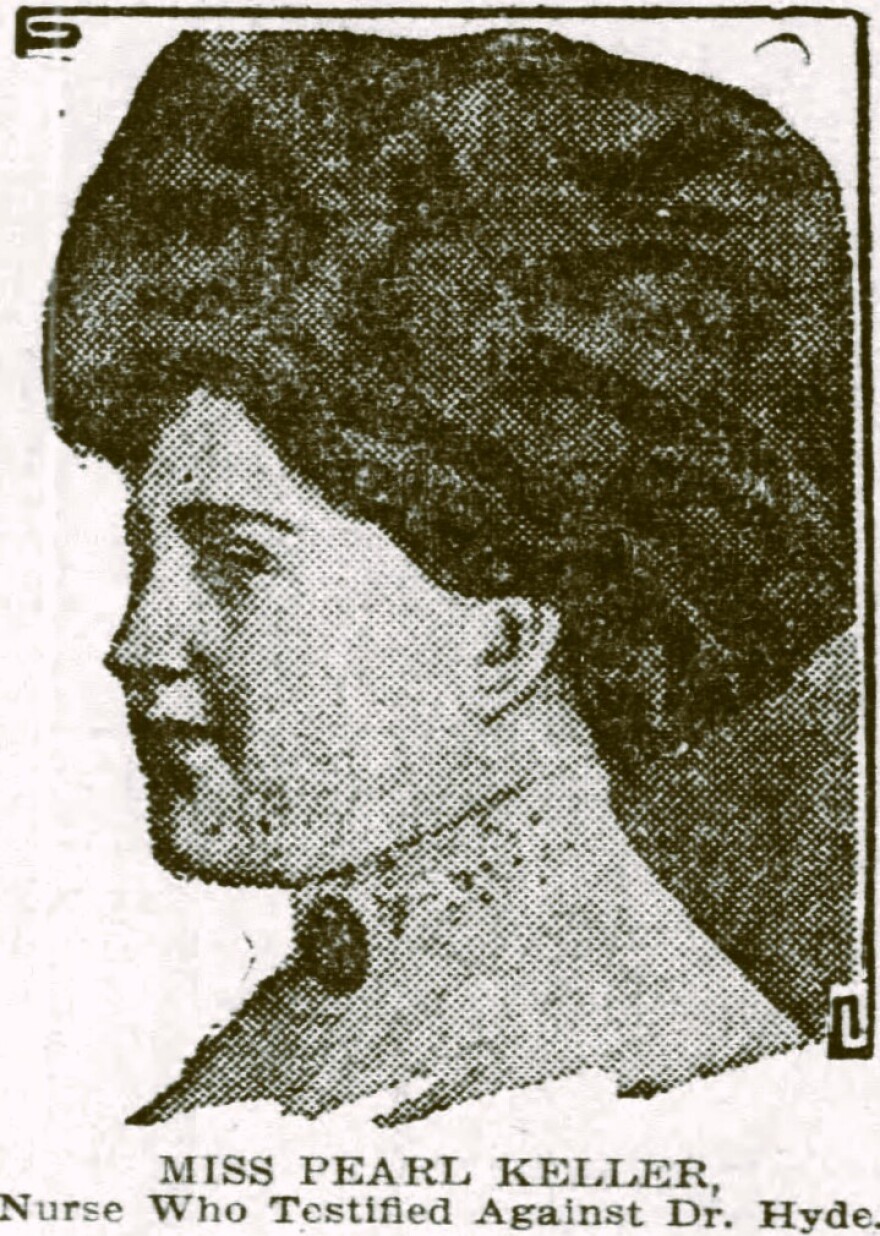
So, while Hyde was out of town one day, Stewart snuck into Hyde’s laboratory to look at Hyde's bacteria cultures.
What he found was that the typhoid culture had been “swept clean” and that there were enough germs removed to “inoculate the whole of Kansas City.”
Stewart wasn't the only one becoming suspicious, either. The first person to really stand up to Hyde's authority during this entire ordeal was the nurse who had been there since the beginning: Pearl Virginia Keller.
“It was really Nurse Keller who got everyone together and approached Dr. Twyman with their suspicions,” Wells says.
In particular, the nurses took umbrage with Hyde’s frequent use of strychnine injections. Strychnine is lethal in large doses, and at the time, it was only used medicinally when the situation called for a stimulant.
“A detail I remember is that the nurses were checking [patients'] heart rates and really saw no need for these strychnine injections,” Wells says.
Led by Keller, the rebel band of nurses gave the Swope family an ultimatum: Either Hyde leaves, or the nurses do.
In the end, Maggie Swope and the family physician tell Hyde to leave the mansion and not come back.
And a funny thing happens when Hyde is gone: The family members afflicted with typhoid start to feel better.
Seven years of legal battles

The Swope family was mostly successful in keeping this familial dispute out of the public eye until shortly after Christmas, when they arranged for independent autopsies of both Chrisman and Thomas Swope.
To avoid publicity, they did Thomas' autopsy in secret, taking his body from Forest Hill Cemetery in the middle of the night. But the newspaper still had a story the very next day anyway.
“The Kansas City Star, the Kansas City Post, the Kansas City Journal… all covered this like one would be following the pitch by pitch of a baseball game,” Monaco says.
“The autopsy results kept getting delayed and delayed and delayed,” Wells says. “People were anxiously awaiting.”
It took 18 days, but the newspapers eventually reported that Thomas and Chrisman Swope had been found to be poisoned with strychnine.
And, even more troubling, they revealed that Swope’s own nephew-in-law was suspected of the two murders.

The case quickly attracted two very high-profile Kansas City lawyers, who were, naturally, old adversaries.
Special prosecutor James A. Reed was a former Kansas City mayor and powerful corporate lawyer associated with the Pendergast machine and the Goat faction of the Kansas City Democratic Party.

Representing the defense was Frank Walsh, a member of the Rabbits, the other Democratic faction in Kansas City.
In February 1910, a coroner’s jury found that Thomas Swope indeed died by strychnine poisoning, which they believed was administered by a capsule.
Then, in March, a grand jury handed down 11 indictments against Hyde, including charges of first degree murder in the deaths of Thomas and Chrisman Swope, and charges of manslaughter in the case of Moss Hunton.
Hyde was also charged with using typhoid germs to poison Margaret Swope, Lucy Lee Swope, Sarah Swope, Stella Swope, and several other people.
The murder trial began in April 1910 to a packed courtroom. National papers sent correspondents from as far as New York and Chicago.
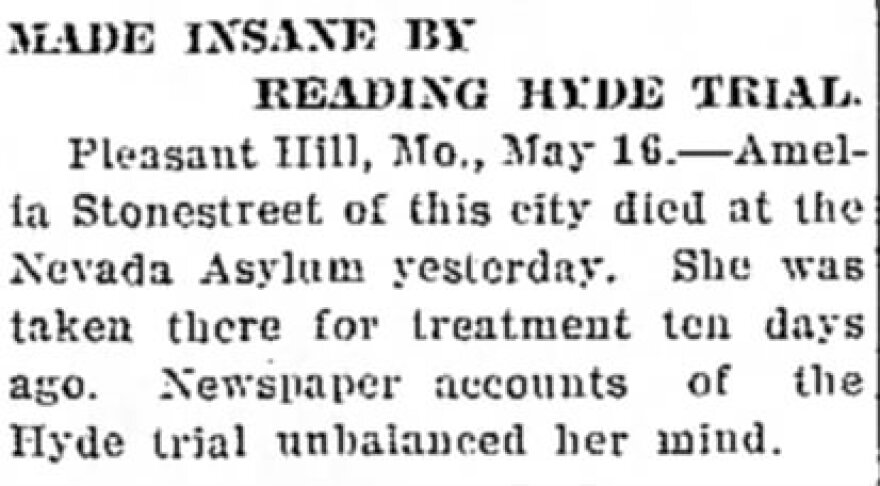
“We like to think that true crime podcasts are sort of a modern invention. But people at the time had the same kind of appetite," Wells says. "They wanted the gruesome details."
Very quickly, Hyde’s trial focused singularly on the murder of Thomas Swope. Everything else became evidence of Hyde’s alleged motive.
The prosecution’s case really rested on the fact that the fewer Swope family members who remained alive, the more Hyde and his wife would stand to inherit from Swope’s fortune.
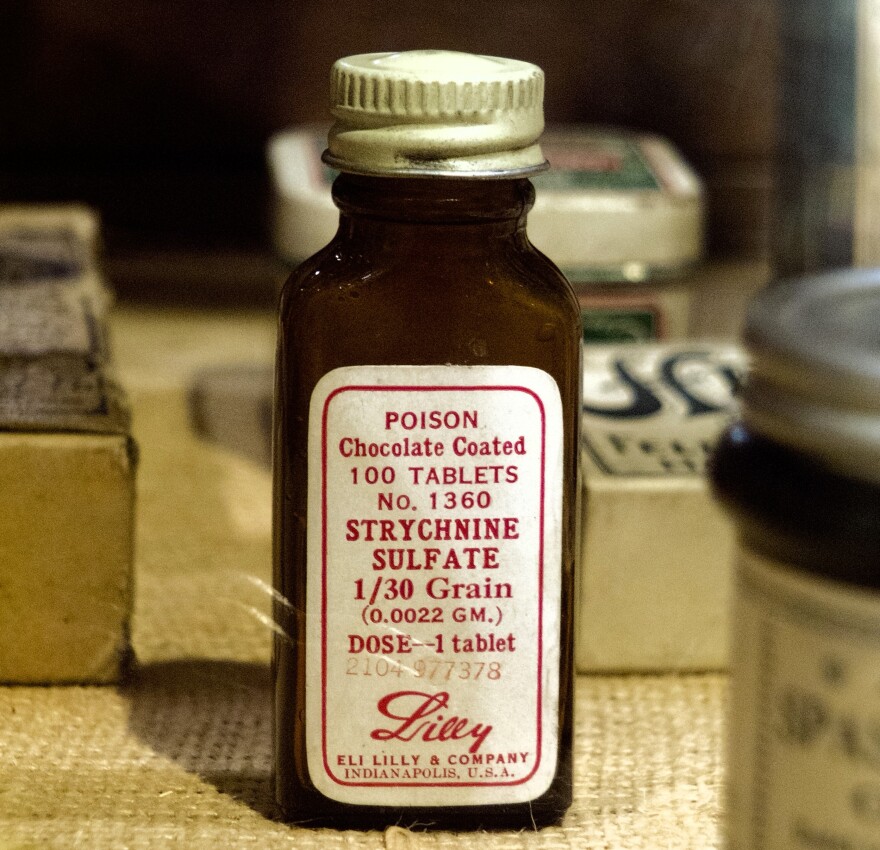
“Strychnine was used in capsules to treat dyspepsia, but not in any quantity that would be toxic, alright?" Monaco says. "So the question was: Did Dr. Hyde add more levels of strychnine to it to make the amount contained within that capsule lethal?”
Meanwhile, Frances Swope and others stood by Hyde’s innocence.
“At the time, Dr. Hyde was a very well connected member of the medical community," Wells says. "Certainly he had a lot of friends in town who did not believe he was guilty, who, I think, couldn't imagine that someone in their own ranks could ever be involved in this kind of thing."
When Hyde took the stand though, he left a lot of questions unanswered. Like, why did he need all of those cyanide capsules?
“Dr. Hyde would testify that he bought the cyanide, put 'em into capsules to kill rats or dogs," Monaco says. "Who the hell poisons dogs with capsules?”
Finally, after three nights and two days of deliberation, the jury found Dr. Bennett Clark Hyde guilty of murdering Colonel Thomas Swope.

The Swope family barely had a moment to celebrate, however, before Frank Walsh filed an appeal to the Missouri Supreme Court, which eventually threw out the verdict.
“They didn't show causation,” Monaco says. “The State of Missouri v. Dr. Hyde's case in the Supreme Court of 1911 is still a leading case on causation and murder cases.”
“The Missouri Supreme Court overturns the conviction basically because evidence of other crimes had been allowed in, when they were really only prosecuting for the Swope murder,” Wells adds.
Another sticking point was the autopsies of Thomas and Chrisman Swope. Monaco says the process was botched after being performed in the dark of night, on frozen corpses.
“That’s why to this day, you’re never gonna be able to convince anybody that Dr. Hyde killed these people,” Monaco says.

Two more trials followed. One was a mistrial because a juror left in the middle of it.
The third was a hung jury, because they couldn’t make up their minds.
There was talk of a fourth trial, but the case got dismissed — and in 1917, Hyde walked free.
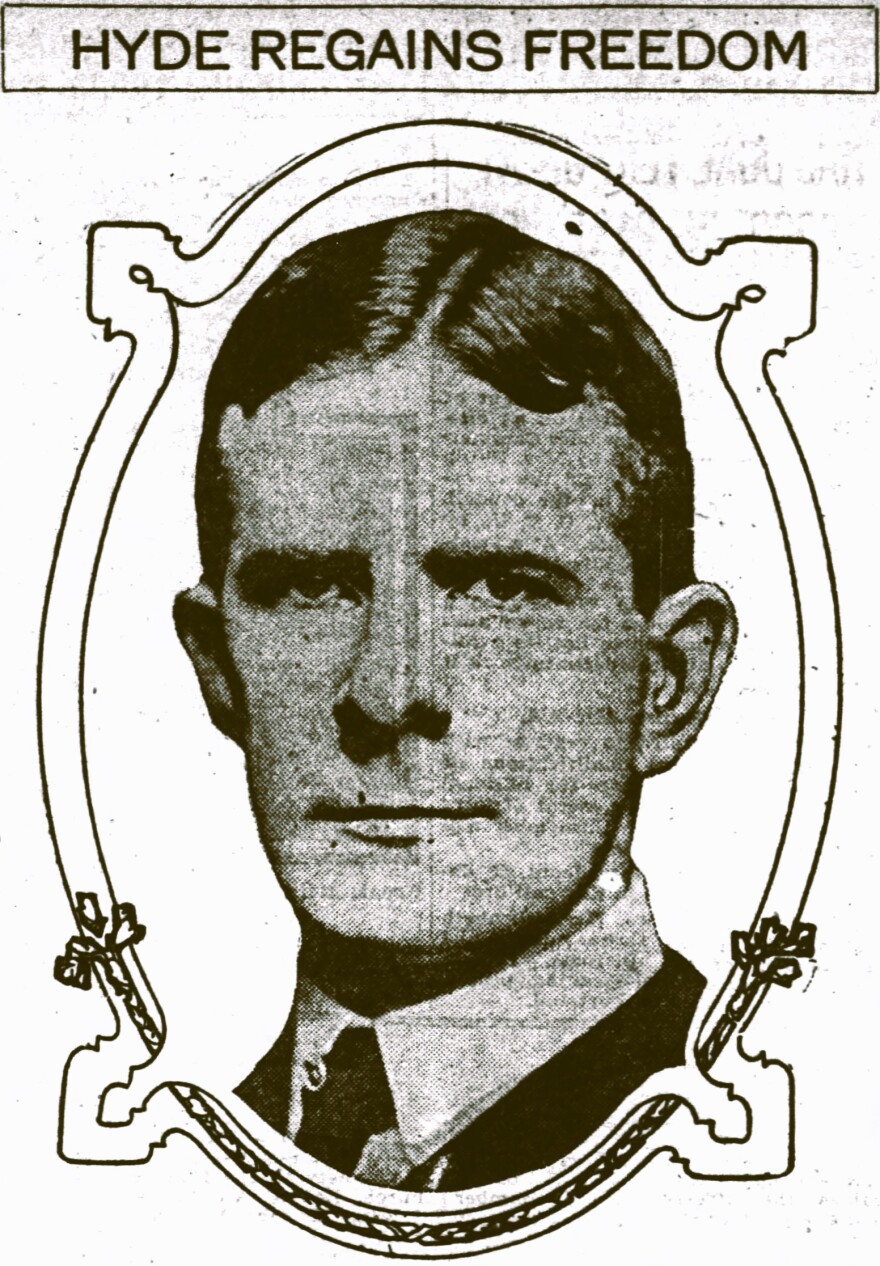
“What I see when I look at the totality of the trial is just another example, if you believe in Dr. Hyde's guilt, of someone who's done terrible things and just through keeping his cool is able to get away with this crime,” Wells says.
His reputation irreparably stained in Kansas City, Hyde moves back to his hometown of Lexington, Missouri. He does a stint as a truck driver and a mechanic, before eventually going back into medicine.
“He comes off as such a cold, calculating figure in history that you can't help but make associations with like a Ted Bundy-type figure," Wells says.
Meanwhile, Frances Hyde divorces Hyde in 1920, gains custody of their kids — James Logan and Frances Hyde — and makes up with her family.
When France's divorce attorney asked her about Hyde's recent disposition, she responded: "He has grown more and more sullen and irritable. He has been very ugly, very disagreeable, very discourteous. He has spoken in impure and vulgar language and has been abusive. He has kept the children in a state of irritation and has taught them to disregard me and my wishes and to show disrespect and to deceive me. I don't want him to see them at all."
But when asked if she believed Hyde was guilty, she responded, "Absolutely not. I stand just as I always stood."
Nine years later, Hyde was interviewed by The Kansas City Star about the presumed guilt he still carried, and spoke bitterly about the years of court cases and public humiliation. But when the reporter responded empathetically, Hyde said, "Don't pity me. Whatever you do, don't pity me."
"I have never pitied myself," he continued. "I have been crucified, yes. I have suffered as no other man has ever suffered... I ask only for justice, simple justice."
Today, Hyde is buried in an unmarked grave at the Machpelah Cemetery in Lexington.
The grand Swope estate in Independence, Missouri — the site of Moss Hunton, Thomas Swope and Chrisman Swope's deaths — was demolished in 1960.
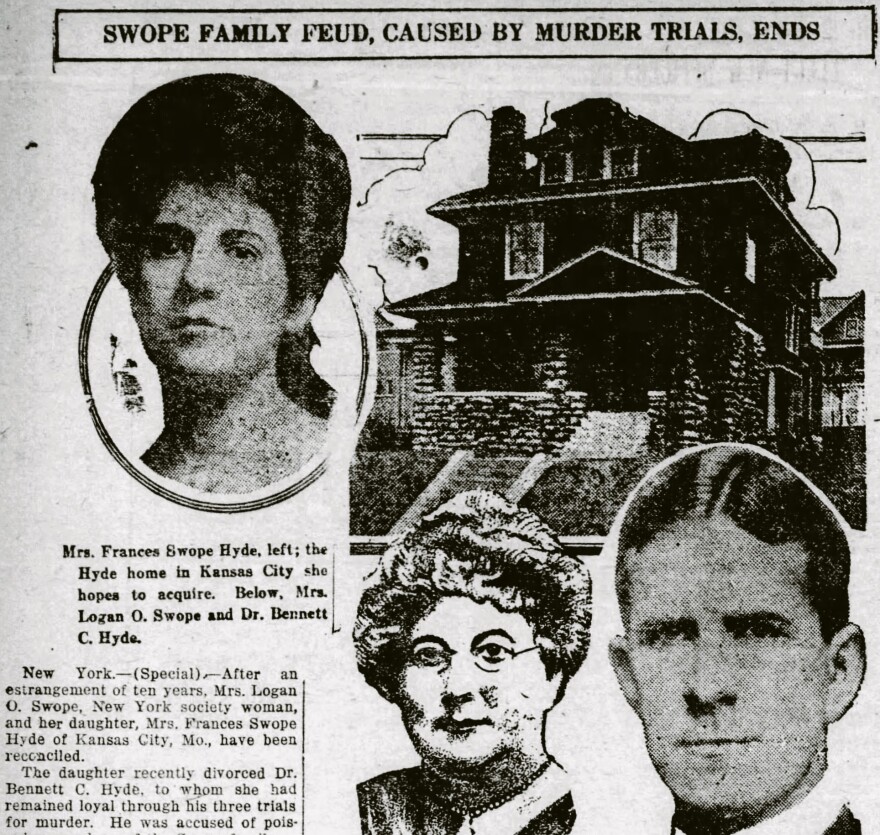
Why this ‘strange case’ endures
It’s easy to get wrapped up in the drama of this story: The mysterious capsules. The fortune. The star-crossed lovers.
"If Dr. Hyde was guilty of what he was accused of doing, he was probably the most villainous, awful criminal in American history. A potential great serial killer," Monaco says.
That’s why Ralph Monaco has spent more than two decades taking part in mock trials reenacting the case at places like the Truman Memorial Building and Union Station. In fact, he's planning another one right now, to be held in spring 2024.
Learning about the mock trial was a pleasant surprise for Becky Swope. She's in her late 60s now, but she grew up in Kansas City being told by her family that she was distantly related to Thomas Swope, although she hasn't been able to firmly track down how.
Years ago, she attended Monaco's mock trial performance with several of her sisters.
“We enjoyed it," she recalls. “It was interesting to see that at one time, there was someone in my family that was that corrupt.”

More than 100 years later, the deaths of Thomas Swope and his family members are still a mystery without a clear, satisfying conclusion.
But the story endures, much for the same reason as the legend of another famous Hyde.
Robert Louis Stevenson’s 1886 Gothic novella, “The Strange Case of Dr. Jekyll and Mr. Hyde,” centers on a well respected scientist, Dr. Jekyll, who lives a double life by transforming into a murderous alter ego known as Mr. Hyde.
Kansas City remains fascinated with the strange case of Colonel Thomas and Dr. Bennett Clark Hyde because of that central, unsolvable question: “Who was Dr. Hyde?”
Was he a good, well-meaning scientist, like Dr. Jekyll, or was he a villainous killer, like Mr. Hyde?
We may never know for sure.
A People's History of Kansas City is hosted by Suzanne Hogan. This episode was reported, produced and mixed by Mackenzie Martin with editing by Gabe Rosenberg.











